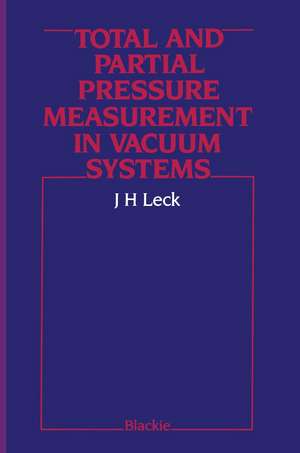Total and Partial Pressure Measurement in Vacuum Systems
Autor John Henry Lecken Limba Engleză Paperback – 9 feb 2012
Preț: 382.75 lei
Nou
Puncte Express: 574
Preț estimativ în valută:
73.24€ • 76.67$ • 60.60£
73.24€ • 76.67$ • 60.60£
Carte tipărită la comandă
Livrare economică 05-19 aprilie
Preluare comenzi: 021 569.72.76
Specificații
ISBN-13: 9781461282242
ISBN-10: 1461282241
Pagini: 212
Ilustrații: VI, 202 p.
Dimensiuni: 152 x 229 x 11 mm
Greutate: 0.29 kg
Ediția:1989
Editura: Springer Us
Colecția Springer
Locul publicării:New York, NY, United States
ISBN-10: 1461282241
Pagini: 212
Ilustrații: VI, 202 p.
Dimensiuni: 152 x 229 x 11 mm
Greutate: 0.29 kg
Ediția:1989
Editura: Springer Us
Colecția Springer
Locul publicării:New York, NY, United States
Public țintă
ResearchCuprins
1 Mechanical manometers.- 1.1 Liquid manometers.- 1.2 The McLeod gauge.- 1.3 The diaphragm manometer.- 1.4 Viscous or friction-type gauges.- References.- 2 Thermal conductivity gauges.- 2.1 Basic principles.- 2.2 Measurement of thermal conductivity.- 2.3 Sensitivity.- 2.4 End losses.- 2.5 Accommodation coefficient and relative sensitivity.- 2.6 Alternative methods of bridge control.- 2.7 Useful range of the constant-voltage bridge.- 2.8 The lower limit to the useful pressure range.- 2.9 The importance of bridge-voltage and temperature fluctuations at high pressure.- 2.10 Compensation for temperature and voltage fluctuations.- 2.11 Physical changes in the gauge wire (ageing effects).- 2.12 Extension of working range to atmospheric pressure.- 2.13 Commercial gauges for laboratory and industrial use.- 2.14 The thermocouple gauge.- References.- 3 Thermionic cathode ionization gauges.- 3.1 Positive ion production in a gas.- 3.2 The principle of the thermionic cathode ionization gauge.- 3.3 The relative sensitivity for different gases.- 3.4 The measurement of low pressures.- 3.5 Extension of the range of the BA gauge to very low pressures.- 3.6 The precision to which measurements can be made with the hot cathode gauge.- 3.7 Gauges specially designed to operate at high pressure.- 3.8 Chemical and physical reactions in the hot cathode ionization gauge.- References.- 4 Cold-cathode ionization gauges.- 4.1 The development of cold-cathode (crossed-field) gauges.- 4.2 Commercial gauges for high- and ultra-high vacuum applications.- References.- 5 Gauge calibration.- 5.1 Basic considerations.- 5.2 Calibration against the transfer gauge.- 5.3 Comparison with absolute gauges.- 5.4 Series expansion techniques.- 5.5 Dynamic flow techniques.- 5.6 The measurement of gas throughput.- References.- 6 Gas analysis in vacuum systems: magnetic, crossed-field and time-of-flight analysers.- 6.1 Introduction.- 6.2 The magnetic deflection mass spectrometer.- 6.3 The trochoidal (or cycloidal) mass spectrometer.- 6.4 The omegatron.- 6.5 Time-of-flight (TOF) mass spectrometer.- 6.6 Interpretation of mass spectra.- References.- 7 Gas analysis in vacuum systems: quadrupole mass analysers.- 7.1 Introduction.- 7.2 Principles of the quadrupole mass filter.- 7.3 Design of small residual gas analysers (RGAs).- 7.4 The operating characteristics of the RGAs designed for general laboratory and industrial use.- 7.5 The use of electron multipliers for signal detection.- 7.6 Non-conventional methods of quadrupole operation.- 7.7 The monopole mass spectrometer.- 7.8 The three-dimensional quadrupole ion trap.- References.



